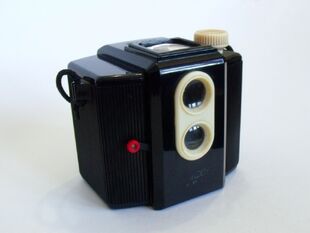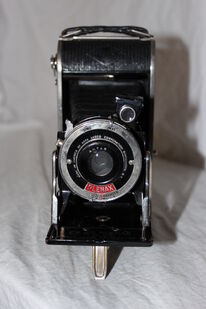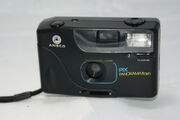Henry Araujo (talk | contribs) |
(changed awkward phrasing) Tag: Visual edit |
||
| (11 intermediate revisions by 4 users not shown) | |||
| Line 4: | Line 4: | ||
In the 19th century its predecessor '''E. & H.T. Anthony Co.''' was the largest distributor of photography supply in the [[United States of America|U.S.A.]]. It started in 1841 or 1842 as [[daguerreotype]] gallery '''Edward Anthony''' in New York and expanded its activity becoming [[photography]] supplier in 1847. In 1852 Edward Anthony's brother Henry T. joined. In 1870 the company started making cameras. The company was the first to patent a roll-film holder that could be loaded in light<ref>Coe, Brian, ''Cameras - from Daguerreotypes to Instant Pictures'', Marshall-Cavendish Editions, 1978, p.80</ref>. |
In the 19th century its predecessor '''E. & H.T. Anthony Co.''' was the largest distributor of photography supply in the [[United States of America|U.S.A.]]. It started in 1841 or 1842 as [[daguerreotype]] gallery '''Edward Anthony''' in New York and expanded its activity becoming [[photography]] supplier in 1847. In 1852 Edward Anthony's brother Henry T. joined. In 1870 the company started making cameras. The company was the first to patent a roll-film holder that could be loaded in light<ref>Coe, Brian, ''Cameras - from Daguerreotypes to Instant Pictures'', Marshall-Cavendish Editions, 1978, p.80</ref>. |
||
| − | In 1902 it was merged with [[Scovill|Scovill & Adams]] into '''[[Ansco|Anthony & Scovill]]''', this name being abbreviated to '''Ansco'''. Ansco took over film maker Goodwin, photo paper maker Columbia and the American Photo Products Co.. Then it was merged with [[Agfa]] in 1928, to be called Agfa-Ansco. Additionally to its own products Ansco began to sell rebadged or licensed cameras of some other makers, especially of Agfa, and it built a new film factory. In 1939 Ansco was renamed to General Aniline & Film (GAF). During WWII the company became state-owned because of its relations to Germany, and was forced to produce sextants and military [[rangefinder (device)|optical rangefinders]], and then it was sold as "enemy |
+ | In 1902 it was merged with [[Scovill|Scovill & Adams]] into '''[[Ansco|Anthony & Scovill]]''', this name being abbreviated to '''Ansco'''. Ansco took over film maker Goodwin, photo paper maker Columbia and the American Photo Products Co.. Then it was merged with [[Agfa]] in 1928, to be called Agfa-Ansco. Additionally to its own products Ansco began to sell rebadged or licensed cameras of some other makers, especially of Agfa, and it built a new film factory. In 1939 Ansco was renamed to General Aniline & Film (GAF). During WWII the company became state-owned because of its relations to Germany, and was forced to produce sextants and military [[rangefinder (device)|optical rangefinders]], and then it was sold as an "enemy asset". |
After the war the company was again '''Ansco''' and reached its peak as camera maker with a production of 2 million cameras per year. Since the 1950s it sold again rebadged cameras, made by Agfa, [[Chinon]], [[Ricoh]] and even [[Minolta]]. The company became GAF (General Aniline & Film) in 1967 and made some [[film]] and [[camera]]s branded '''GAF''', and in 1978, [[Haking|Haking of Hong Kong]] acquired the rights to the '''Ansco''' trademark. Ansco cameras continued to be made until the 1990s by Haking, while GAF became '''Anitec'''. In 1992 Anitec celebrated the company's 150th anniversary. It became part of a group which was taken over by [[Kodak]]. The factory in Binghamton was closed in 1998 and demolished in 2000. |
After the war the company was again '''Ansco''' and reached its peak as camera maker with a production of 2 million cameras per year. Since the 1950s it sold again rebadged cameras, made by Agfa, [[Chinon]], [[Ricoh]] and even [[Minolta]]. The company became GAF (General Aniline & Film) in 1967 and made some [[film]] and [[camera]]s branded '''GAF''', and in 1978, [[Haking|Haking of Hong Kong]] acquired the rights to the '''Ansco''' trademark. Ansco cameras continued to be made until the 1990s by Haking, while GAF became '''Anitec'''. In 1992 Anitec celebrated the company's 150th anniversary. It became part of a group which was taken over by [[Kodak]]. The factory in Binghamton was closed in 1998 and demolished in 2000. |
||
| Line 43: | Line 43: | ||
* [[Agfa Karat|Ansco Karomat]] |
* [[Agfa Karat|Ansco Karomat]] |
||
* [[Ansco Lancer]] |
* [[Ansco Lancer]] |
||
| + | * Ansco M35 point and shot |
||
* Ansco Marvel S-20 (made for Sears) |
* Ansco Marvel S-20 (made for Sears) |
||
* [[Ansco Memar]] and [[Ansco Super Memar]] |
* [[Ansco Memar]] and [[Ansco Super Memar]] |
||
| Line 51: | Line 52: | ||
* Ansco No 3A Folding |
* Ansco No 3A Folding |
||
* Ansco No 6 Folding |
* Ansco No 6 Folding |
||
| − | * [[Ansco Panda]] <gallery widths="310"> |
+ | * [[Ansco Panda]] <gallery widths="310" navigation="true"> |
Ansco Panda.JPG|The Ansco Panda|link=http://www.flickr.com/photos/52013582@N07/6876006351/ |
Ansco Panda.JPG|The Ansco Panda|link=http://www.flickr.com/photos/52013582@N07/6876006351/ |
||
cameras 020.JPG|Agfa PB 20 Plenax |
cameras 020.JPG|Agfa PB 20 Plenax |
||
| Line 58: | Line 59: | ||
* Ansco Pix Panorama |
* Ansco Pix Panorama |
||
* [[ Ansco Pix Panorama flash]] [[File:DSC02455.jpg|thumb|ANSCO PIX PANORAMA flash]] |
* [[ Ansco Pix Panorama flash]] [[File:DSC02455.jpg|thumb|ANSCO PIX PANORAMA flash]] |
||
| + | * Ansco Pix 2000 |
||
* [[Ansco Plenax PB20]] |
* [[Ansco Plenax PB20]] |
||
* [[Readyflash|Ansco Readyflash]] |
* [[Readyflash|Ansco Readyflash]] |
||
| Line 82: | Line 84: | ||
AGFA Ansco B-2 Shur-Shot (Regular).JPG|The Ansco Shur-Shot "B-2" Regular|link=http://www.flickr.com/photos/52013582@N07/7142213425/ |
AGFA Ansco B-2 Shur-Shot (Regular).JPG|The Ansco Shur-Shot "B-2" Regular|link=http://www.flickr.com/photos/52013582@N07/7142213425/ |
||
</gallery> |
</gallery> |
||
| + | * Ansco Silhouette motorized |
||
* Ansco Special No. 2 |
* Ansco Special No. 2 |
||
* Ansco Special No. 2A |
* Ansco Special No. 2A |
||
| Line 89: | Line 92: | ||
* [[Ansco Universal View Camera]] |
* [[Ansco Universal View Camera]] |
||
* Anscomatic Cadet Flash |
* Anscomatic Cadet Flash |
||
| − | * Ansco |
+ | * [[Ansco Viking 6.3]] |
| + | * Ansco Vision I flash |
||
=== Camera kit=== |
=== Camera kit=== |
||
* Craftsman Camera Kit |
* Craftsman Camera Kit |
||
| Line 118: | Line 122: | ||
* Ansco Pixie |
* Ansco Pixie |
||
| − | * Ansco Vision |
+ | * Ansco Vision Twin•Lens motorized |
* Ansco 50 |
* Ansco 50 |
||
* Ansco 60 |
* Ansco 60 |
||
| Line 124: | Line 128: | ||
* Ansco 600 |
* Ansco 600 |
||
* Ansco 633 |
* Ansco 633 |
||
| + | |||
| + | ==Ansco Flashes== |
||
| + | * Ansco bulb flashlamp 5 inch reflector |
||
==Notes and references== |
==Notes and references== |
||
| Line 148: | Line 155: | ||
*[http://www.collection-appareils.fr/x/html/frise_histo_Ansco.php Ansco Cameras Timeline] at www.collection-appareils.com |
*[http://www.collection-appareils.fr/x/html/frise_histo_Ansco.php Ansco Cameras Timeline] at www.collection-appareils.com |
||
| − | [[Category: |
+ | [[Category:Camera makers]] |
| − | [[Category: |
+ | [[Category:Film makers]] |
| − | [[Category: |
+ | [[Category:Ansco|*]] |
| − | [[Category: |
+ | [[Category:USA]] |
Latest revision as of 13:28, 12 April 2020
Ansco was an American manufacturer of camera equipment in Binghamton, New York.
In the 19th century its predecessor E. & H.T. Anthony Co. was the largest distributor of photography supply in the U.S.A.. It started in 1841 or 1842 as daguerreotype gallery Edward Anthony in New York and expanded its activity becoming photography supplier in 1847. In 1852 Edward Anthony's brother Henry T. joined. In 1870 the company started making cameras. The company was the first to patent a roll-film holder that could be loaded in light[1].
In 1902 it was merged with Scovill & Adams into Anthony & Scovill, this name being abbreviated to Ansco. Ansco took over film maker Goodwin, photo paper maker Columbia and the American Photo Products Co.. Then it was merged with Agfa in 1928, to be called Agfa-Ansco. Additionally to its own products Ansco began to sell rebadged or licensed cameras of some other makers, especially of Agfa, and it built a new film factory. In 1939 Ansco was renamed to General Aniline & Film (GAF). During WWII the company became state-owned because of its relations to Germany, and was forced to produce sextants and military optical rangefinders, and then it was sold as an "enemy asset".
After the war the company was again Ansco and reached its peak as camera maker with a production of 2 million cameras per year. Since the 1950s it sold again rebadged cameras, made by Agfa, Chinon, Ricoh and even Minolta. The company became GAF (General Aniline & Film) in 1967 and made some film and cameras branded GAF, and in 1978, Haking of Hong Kong acquired the rights to the Ansco trademark. Ansco cameras continued to be made until the 1990s by Haking, while GAF became Anitec. In 1992 Anitec celebrated the company's 150th anniversary. It became part of a group which was taken over by Kodak. The factory in Binghamton was closed in 1998 and demolished in 2000.
Camera List[]

|
| 1911 Ansco Dollar Box Camera |
- Agfa Memo
- Ansco 50
- Ansco Anscoflex
- Ansco Anscomark M
- Ansco Anscoset
- Ansco Arrow
- Ansco Automatic Reflex
- Ansco Autoset
- Ansco Buster Brown No. 2A
- Ansco Buster Brown No. 2
- Ansco Buster Brown No. 3A
- Ansco Buster Brown No. 3
- Ansco "B-2" Cadet
- Ansco Cadet II
- Ansco Cadet Reflex
- Ansco Clipper
- Ansco Dollar
- Ansco Flash Clipper
- Ansco No. 3A Folding Buster Brown
- Ansco Isolette
- Ansco Junior
- Ansco Karomat
- Ansco Lancer
- Ansco M35 point and shot
- Ansco Marvel S-20 (made for Sears)
- Ansco Memar and Ansco Super Memar
- Ansco Memo
- Ansco Memo II (Half-frame)
- Ansco No 1A Folding
- Ansco No 2A Folding
- Ansco No 3A Folding
- Ansco No 6 Folding
- Ansco Panda
- Ansco Pioneer (also badged as the "Ansco Jr. Press Photographer")
- Ansco Pix Panorama
- Ansco Pix Panorama flash

ANSCO PIX PANORAMA flash
- Ansco Pix 2000
- Ansco Plenax PB20
- Ansco Readyflash
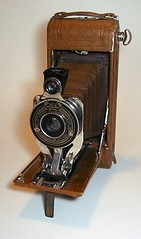
|
| Readyset Royal No. 1A |
- Ansco Readyset
- Ansco Readyset Royal No. 1A
- Ansco Readyset Special
- Ansco Readyset Traveler
- Ansco Rediflex
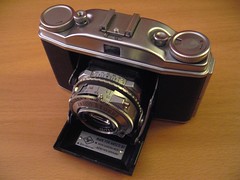
|
| Ansco Regent |
- Ansco Regent
- Ansco Shur Flash
- Ansco Shur Shot
- Ansco Silhouette motorized
- Ansco Special No. 2
- Ansco Special No. 2A
- Ansco Speedex
- Ansco Super Speedex
- Ansco Super Regent
- Ansco Universal View Camera
- Anscomatic Cadet Flash
- Ansco Viking 6.3
- Ansco Vision I flash
Camera kit[]
- Craftsman Camera Kit
Disc Cameras[]
- Ansco 105, Ansco 105 Telephoto
- Ansco 310
- Ansco 320
- Ansco 330
- Ansco 340
- Ansco 350
- Ansco 370
- Ansco 380 telephoto
- Ansco Cadet 100
- Ansco Disc 103
- Ansco Fiesta, Ansco Fiesta Tele
- Ansco HR10, Ansco Memo HR10, Ansco HR10T
- Ansco HR15
- Ansco HR20
- Ansco HR25
- Ansco HR30
- Ansco HR40
- Ansco HR50
- Ansco HR65
- Ansco Ready Flash VR1
110 cameras[]
- Ansco Pixie
- Ansco Vision Twin•Lens motorized
- Ansco 50
- Ansco 60
- Ansco 500 slim pix
- Ansco 600
- Ansco 633
Ansco Flashes[]
- Ansco bulb flashlamp 5 inch reflector
Notes and references[]
- ↑ Coe, Brian, Cameras - from Daguerreotypes to Instant Pictures, Marshall-Cavendish Editions, 1978, p.80
Links[]
In English:
- about Anthony
- E. & H.T. Anthony, company and cameras, at Field Cameras of the United States [1]
- E. & H.T. Anthony Company at historic camera [2]
- about Ansco
- Chronology on Bill's Photo History [3]
- Wikipedia Ansco entry
- Ansco Half-Frame Cameras
- Ansco camera manuals at www.orphancameras.com
- Ansco Cameras Price Guide at CollectiBlend
- Ansco patents
- Ansco Supreme "Panchromatic" 35mm Film picture and additional information at "Antique_Camera_Guy's" Flickr Photostream
In English and French:
In French:
- Ansco Cameras Timeline at www.collection-appareils.com

